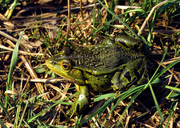|
Pelophylax nigromaculatus (Hallowell, 1861)
Dark-Spotted Frog | family: Ranidae genus: Pelophylax |
 B. Thiesmeier © PENSOFT Publishers (1 of 4)
|
|
|
|
Description Distribution and Habitat Country distribution from AmphibiaWeb's database: China, Japan, Korea, Democratic People's Republic of, Korea, Republic of, Russian Federation, Taiwan
The Dark-Spotted Frog lives in meadows, different types of forests, bushlands and in desert (Turkmenia). Within these landscape types, it inhabits different types of water bodies, including river pools, channels, lakes, ponds, swamps, ditches and rice fields. In Turkmenia, the frog is strictly associated with riparian, overgrown parts of ponds, channels and irrigation ditches, whereas in the Far East it regularly occurs 2-15 m from water. In general, however, this frog displays a high site-fidelity. As a rule, it uses stagnant waters, rarely occurring in the shallows of rivers, covered with dense vegetation. It should be noted that in Turkmenia this species lives mainly separately from its relative, the autochthonous Marsh Frog (Rana ridibunda). Only in few ponds do these two species co-occur. Life History, Abundance, Activity, and Special Behaviors Tadpoles consume primarily plants (algae etc.). Adults primarily eat spiders, terrestrial insects and other invertebrates. Vertebrates (fish fry, amphibians etc.) are rarely eaten. Feeding does not cease during the breeding season. Relation to Humans Comments
References
Bannikov, A. G., Darevsky, I. S., Ishchenko, V. G., Rustamov, A. K., and Szczerbak, N. N. (1977). Opredelitel Zemnovodnykh i Presmykayushchikhsya Fauny SSSR [Guide to Amphibians and Reptiles of the USSR Fauna]. Prosveshchenie, Moscow. Fei, L. (1999). Atlas of Amphibians of China. Henan Publishing House of Science and Technology, Zhengzhou. Kuzmin, S. L. (1995). Die Amphibien Russlands und angrenzender Gebiete. Westarp Wissenschaften, Magdeburg. Kuzmin, S. L. (1999). The Amphibians of the Former Soviet Union. Pensoft, Sofia-Moscow. Nishioka, M., Sumida, M. and Ohtani, H. (1992). ''Differentiation of 70 populations in the Rana nigromaculata group by the method of electrophoretic analysis.'' Scientific Report of the Laboratory for Amphibian Biology Hiroshima University, 11(1), 1-70. Stejneger, L. H. (1907). Herpetology of Japan and Adjacent Territory, United States National Museum Bulletin 58. Smithsonian Institution, Washington, D. C.. Terent'ev, P. V. and Chernov, S. A (1965). Key to Amphibians and Reptiles [of the USSR]. Israel Program for Scientific Translations, Jerusalem. Won, H.-K. (1971). Choson Ryangso Pyachyungryuchji [Amphibian and Reptilian Fauna of Korea]. Korean Academy of Sciences, Pyongyang. Ye, C., Fei, L., and Hu, S. Q. (1993). Rare and Economic Amphibians of China. Sichuan Publishing House of Science and Technology, Chengdu. Zhao, E. and Adler, K. (1993). Herpetology of China. Society for the Study of Amphibians and Reptiles, Oxford, Ohio. Zhao, E. and Zhao, H. (1994). Chinese Herpetological Literature: Catalogue and Indices. Chengdu University of Science and Technology, Chengdu. Originally submitted by: Sergius L. Kuzmin (first posted 1999-11-10) Edited by: Kellie Whittaker (2007-12-06) Species Account Citation: AmphibiaWeb 2007 Pelophylax nigromaculatus: Dark-Spotted Frog <https://amphibiaweb.org/species/5109> University of California, Berkeley, CA, USA. Accessed May 13, 2025.
Feedback or comments about this page.
Citation: AmphibiaWeb. 2025. <https://amphibiaweb.org> University of California, Berkeley, CA, USA. Accessed 13 May 2025. AmphibiaWeb's policy on data use. |





 Map of Life
Map of Life